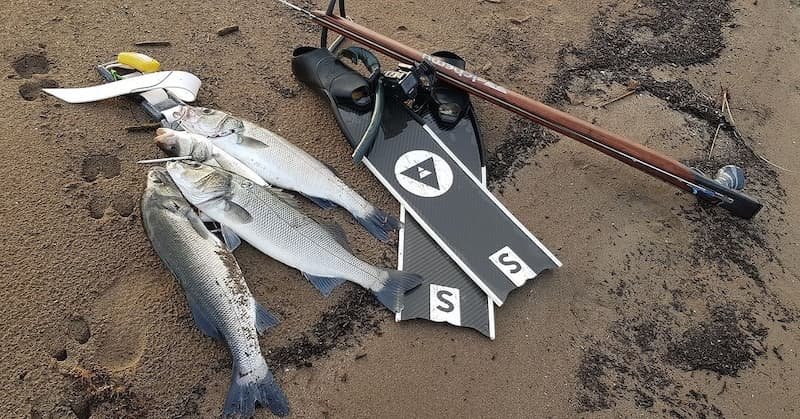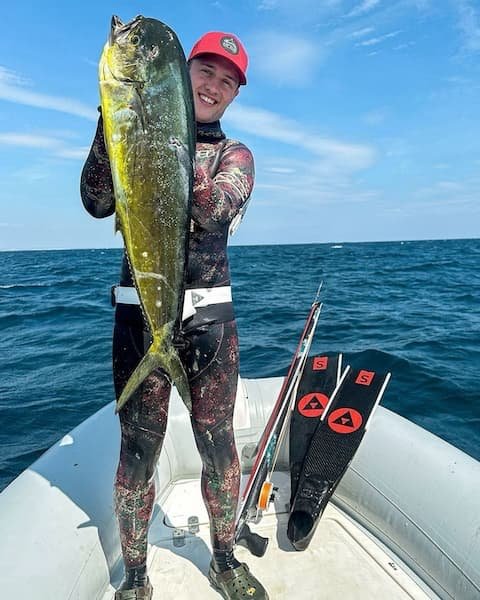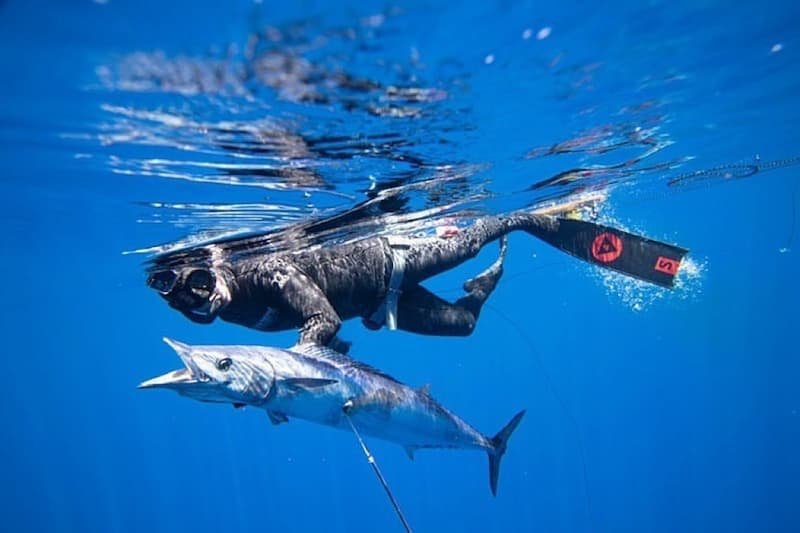
 Roni Essex
Freediver, Spearo, Creator
Roni Essex
Freediver, Spearo, Creator

 Roni Essex
Freediver, Spearo, Creator
Roni Essex
Freediver, Spearo, Creator
Spearfishing, while an exhilarating and time-honored activity, comes with a responsibility that goes beyond mastering technique or acquiring the best gear. As with any interaction with nature, ethical practices are essential to ensure the sustainability of marine life. In recent years, increasing awareness of marine conservation and the impact of overfishing has led to greater scrutiny of spearfishing practices. One of the most important lessons for any spearfisherman, whether seasoned or just starting, is the importance of targeting fish of the right size and avoiding protected species. This not only supports the health of ecosystems but also helps maintain the balance of marine populations for future generations to enjoy.
This blog post will dive into the reasons behind size limits, the importance of understanding protected species, and the critical role that education plays in preventing newbies from contributing to overfishing or harming vulnerable species.
Marine ecosystems are delicately balanced, and each species plays a specific role in maintaining that equilibrium. Fish size and weight limits are established based on the biology and reproductive behaviors of different species. Generally, size limits are set to ensure that a fish has had the opportunity to reproduce at least once before being harvested.
Fish reproduce at different stages of life, and allowing them to reach sexual maturity is crucial for sustaining fish populations. For many species, maturity is closely tied to size rather than age. For example, a fish may grow rapidly during its early years but will not become sexually mature until it reaches a specific length. By targeting fish that have not yet reached this size, spearfishers may inadvertently reduce the species' ability to replenish itself. For instance, in the Mediterranean, the European seabass (Dicentrarchus labrax) has been shown to reach reproductive maturity at around 42 cm for females. By ensuring that spearfishers only take individuals above this size, we give the species a better chance to sustain itself.
Overfishing occurs when too many fish are taken from a population before they can reproduce, leading to a rapid decline in numbers. This can have severe repercussions not only for the targeted species but also for the predators and prey in the food web. Data from the Food and Agriculture Organization (FAO) reveal that nearly 90% of the world’s marine fish stocks are either fully exploited or overfished, with certain species already nearing collapse. This is particularly evident in regions where recreational spearfishing is popular but lacks stringent regulation or enforcement. By respecting size and weight limits, spearfishers contribute to reducing overfishing pressure on certain species, particularly those at risk of population declines.

Beyond size limits, it is vital to understand which species are protected and why. Protected species are those that are either endangered, threatened, or play a critical role in the ecosystem. International agreements like CITES (the Convention on International Trade in Endangered Species) and regional regulations often determine which species should not be fished. These rules vary from location to location, making it essential for spearfishers to research and understand the specific regulations that apply in the areas they dive.
Some fish species are apex predators or keystone species that have an outsized impact on their environment. For example, grouper and snapper are important predators that help control the populations of smaller fish and invertebrates. If their numbers dwindle, the entire ecosystem can become unbalanced, leading to overpopulation of certain species and depletion of others. In many tropical locations, certain species of grouper, like the Nassau grouper (Epinephelus striatus), are protected due to their dwindling numbers and critical role in the coral reef ecosystem. Hunting these species not only puts them at risk but also disrupts the ecological balance of the reefs they inhabit.
Overfishing, habitat destruction, and pollution have pushed some species to the brink of extinction. For example, the bluefin tuna is heavily targeted due to its high market value, and populations have plummeted. Although not typically a species spearfishers target, it serves as an example of how critical it is to know what you're hunting. Many regions have local species that are similarly at risk, and spearfishers must educate themselves about these species to avoid accidentally contributing to their decline. In the Mediterranean, the dusky grouper (Epinephelus marginatus) is protected in some areas due to its slow growth and long life cycle, making it vulnerable to overfishing.

For new spearfishers, the excitement of the hunt can sometimes overshadow responsible practices. Many beginners, unaware of local regulations or the importance of species conservation, may inadvertently target juvenile fish or protected species. This is why education is critical in the spearfishing community, especially for those just starting their journey.
Experienced spearfishers have a responsibility to educate newcomers about the ethical side of the sport. This includes teaching them how to properly identify fish species, understand local size and catch limits, and recognize protected species. When this knowledge is shared and passed on from generation to generation, it fosters a culture of sustainability that benefits both the sport and the marine environment. Many spearfishing clubs and organizations have stepped up to address this need, offering workshops, certifications, and resources to help new spearfishers understand the importance of these principles. Social media platforms, YouTube channels, and online forums have also become invaluable resources for newbies to learn from experienced spearfishers worldwide.
One of the most common mistakes new spearfishers make is adopting a “shoot first, ask later” mentality. This approach often leads to the unnecessary killing of fish that are too small, non-target species, or even protected species. To avoid this, new spearfishers should be taught to identify their targets before pulling the trigger. The importance of selective hunting cannot be overstated. Spearfishers should have a clear understanding of the fish they are hunting before they enter the water, and they should be able to recognize the size, color, and behavior of their target species. This allows them to make more informed decisions about which fish to pursue.

Beyond adhering to regulations and size limits, spearfishers can play an active role in conservation efforts. In many regions, spearfishers are often the first to notice changes in fish populations and ecosystem health, making them valuable contributors to marine research and conservation programs.
Marine Protected Areas (MPAs) are regions of the ocean where human activity is restricted to protect marine ecosystems and biodiversity. Spearfishers can support these areas by respecting the boundaries and regulations in place and even by participating in research or monitoring activities. Many spearfishers work closely with local conservation organizations to track fish populations, report illegal activities, and contribute to scientific studies.
Some spearfishers participate in citizen science projects, where they log their catches and report data to marine research organizations. This data helps scientists track fish populations and assess the health of marine ecosystems. By contributing to these efforts, spearfishers become valuable partners in the fight to preserve marine biodiversity.

Laws and regulations regarding spearfishing vary greatly depending on the location. In some regions, spearfishing is tightly regulated, with specific seasons, size limits, and species restrictions. In others, spearfishing remains largely unregulated, which increases the risk of overfishing and harming vulnerable species.
Spearfishers must be aware of the legal regulations in their area and respect them at all times. This includes obtaining any necessary licenses, respecting closed seasons, and adhering to bag limits. In addition to legal considerations, spearfishers should always strive to operate ethically, considering the long-term impact of their actions on the environment.

Spearfishing is a sport deeply rooted in tradition and human connection with the ocean. However, with that connection comes the responsibility to ensure that future generations can enjoy the same experiences without compromising the health of our oceans. Targeting the right size and weight of fish and avoiding protected species are two of the most critical ways spearfishers can contribute to the sustainability of marine life.
New spearfishers must be educated about these principles from the start, fostering a mindset of respect for the marine environment. By adhering to size and weight limits, avoiding protected species, and participating in conservation efforts, spearfishers can continue to enjoy the thrill of the hunt while ensuring that the oceans remain vibrant and full of life for generations to come.